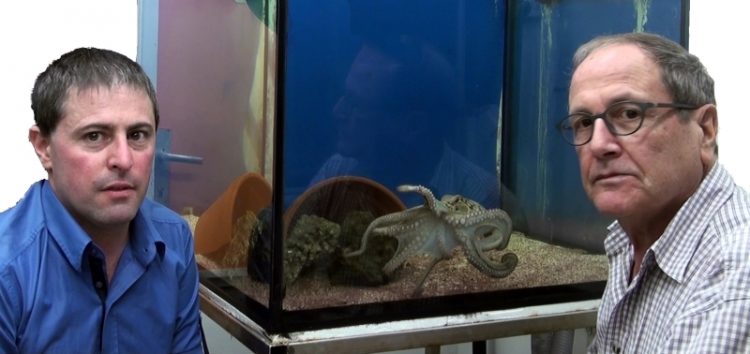Octopuses Have a Unique Way to Control Their 'Odd' Forms

Mapping how octopuses control their movement: Dr. Guy Levy (L) and Prof. Benny Hochner at the Hebrew University of Jerusalem's Octopus Research Group. For videos, see below. (Photo: Hebrew University)
The body plan of octopuses is nothing if not unique, with a sophisticated brain in a soft, bilaterally symmetrical body, encircled by eight radially symmetrical and incredibly flexible arms.
Now, reporting the first detailed kinematic analysis of octopus arm coordination in crawling, researchers from the Hebrew University of Jerusalem show that the animals have a unique motor control strategy to match their “odd” form. The researchers report their findings in the Cell Press journal Current Biology.
“Octopuses use unique locomotion strategies that are different from those found in other animals,” says Prof. Binyamin (Benny) Hochner, Principal Investigator at the Hebrew University of Jerusalem's Octopus Research Group. “This is most likely due to their soft molluscan body that led to the evolution of ‘strange’ morphology, enabling efficient locomotion control without a rigid skeleton.”
Earlier studies of octopus behavior by the Hebrew University team have focused on goal-directed arm movements, like reaching to a target or fetching food to the mouth, Hochner explains.
(See, for instance, http://www.eurekalert.org/pub_releases/2006-04/cp-hto041306.php , http://www.eurekalert.org/pub_releases/2014-05/cp-hod050714.php , and
http://www.eurekalert.org/pub_releases/2011-05/thuo-hur051811.php ). The new study is the first to tackle a larger question: how octopuses manage to coordinate their eight long, flexible arms during locomotion.
Octopuses most likely evolved from animals more similar to clams, with a protective outer shell and almost no movement to speak of. “During evolution, octopuses lost their heavy protective shells and became more maneuverable on the one hand, but also more vulnerable on the other hand,” says Hebrew University co-author Dr. Guy Levy, of the Department of Neurobiology and the Edmond & Lily Safra Center for Brain Sciences. “Their locomotory abilities evolved to be much faster than those of typical molluscs, probably to compensate for the lack of shell.”
The evolution of a typical snail’s foot into long and slender arms gave octopuses extraordinary flexibility. Excellent vision, together with a highly developed and large brain and the ability to color camouflage, made cephalopods very successful hunters. But how do they control the movements of those remarkable bodies?
After poring over videos of octopuses in action, frame by frame, the researchers made several surprising discoveries. Despite its bilaterally symmetrical body, the octopus can crawl in any direction relative to its body orientation. The orientation of its body and crawling direction are independently controlled, and its crawling lacks any apparent rhythmical patterns in limb coordination.
Hochner, Levy, and their colleagues show that this uncommon maneuverability of octopuses is derived from the radial symmetry of their arms around the body and the simple mechanism by which the arms create the crawling thrust: pushing-by-elongation.
“These two together enable a mechanism whereby the central controller chooses in a moment-to-moment fashion which arms to recruit for pushing the body in an instantaneous direction,” the researchers write. The animal needs only to choose which arms to activate in order to determine the direction of locomotion.
The findings lend support to what’s known as the Embodied Organization concept. In the traditional view, motor-control strategies are devised to fit the body. But, the researchers say, under Embodied Organization, the control and the body evolve together in lockstep within the context of the environment with which those bodies interact.
“This concept, which is borrowed from robotics, argues that the optimal behavior of an autonomous robot or an animal is achieved as a result of the optimization of the reciprocal and dynamical interactions between the brain, body, and the constantly changing environment, thus leading to optimal adaptation of the system, as a whole, to its ecological niche,” Levy says. “Another important virtue of this type of organization is that every level, including the physical properties and the morphology, contribute to the control of the emerging behavior—and not only the brain, as we tend to think.”
Levy and Hochner say their next step is to uncover the neural circuits involved in the octopuses’ coordinated crawling.
The research was supported by the European Commission EP-7 projects OCTOPUS and STIFF-FLOP.
Videos accompanying this press release are available for download at:
http://media.huji.ac.il/new/multimedia/hu150516_LevyOctopusCrawling_MovieS1.mp4
http://media.huji.ac.il/new/multimedia/hu150516_LevyOctopusCrawling_MovieS2.mp4
http://media.huji.ac.il/new/multimedia/hu150516_LevyOctopus.mp4
(CREDIT: Videos courtesy Dr. Guy Levy / Hebrew University Octopus Research Group)
Original press release text courtesy of Cell Press.
To contact the researchers:
Prof. Benny Hochner: Benny.Hochner@mail.huji.ac.il
Dr. Guy Levy: Guy.Levy@mail.huji.ac.il
Media contact:
Dov Smith
The Hebrew University of Jerusalem
+972-2-5882844 / +972-54-8820860
dovs@savion.huji.ac.il
Media Contact
All latest news from the category: Life Sciences and Chemistry
Articles and reports from the Life Sciences and chemistry area deal with applied and basic research into modern biology, chemistry and human medicine.
Valuable information can be found on a range of life sciences fields including bacteriology, biochemistry, bionics, bioinformatics, biophysics, biotechnology, genetics, geobotany, human biology, marine biology, microbiology, molecular biology, cellular biology, zoology, bioinorganic chemistry, microchemistry and environmental chemistry.
Newest articles

A ‘language’ for ML models to predict nanopore properties
A large number of 2D materials like graphene can have nanopores – small holes formed by missing atoms through which foreign substances can pass. The properties of these nanopores dictate many…

Clinically validated, wearable ultrasound patch
… for continuous blood pressure monitoring. A team of researchers at the University of California San Diego has developed a new and improved wearable ultrasound patch for continuous and noninvasive…

A new puzzle piece for string theory research
Dr. Ksenia Fedosova from the Cluster of Excellence Mathematics Münster, along with an international research team, has proven a conjecture in string theory that physicists had proposed regarding certain equations….



